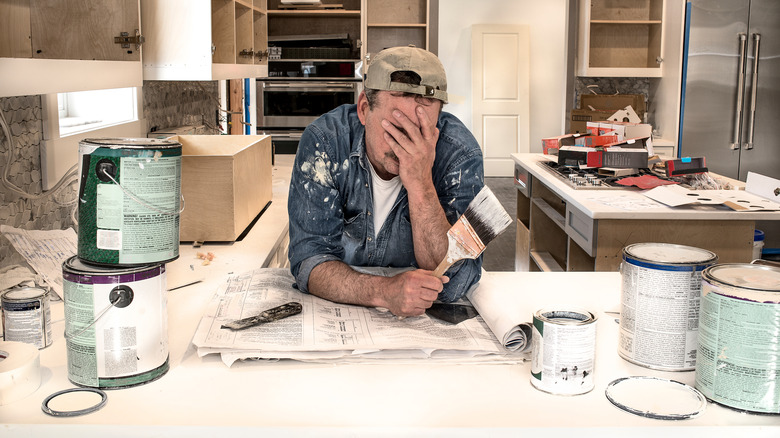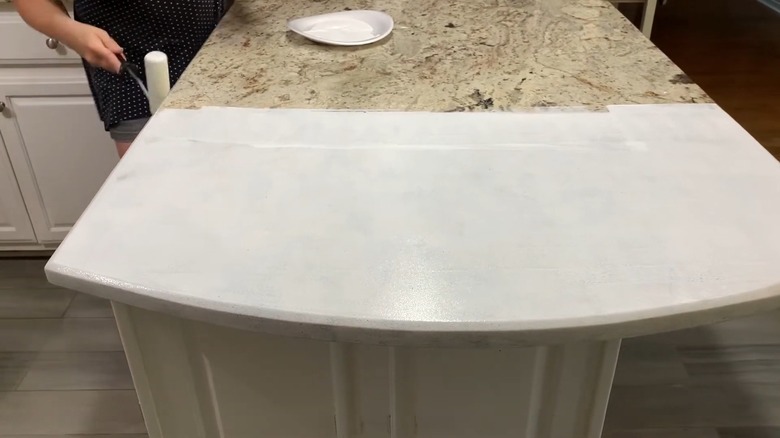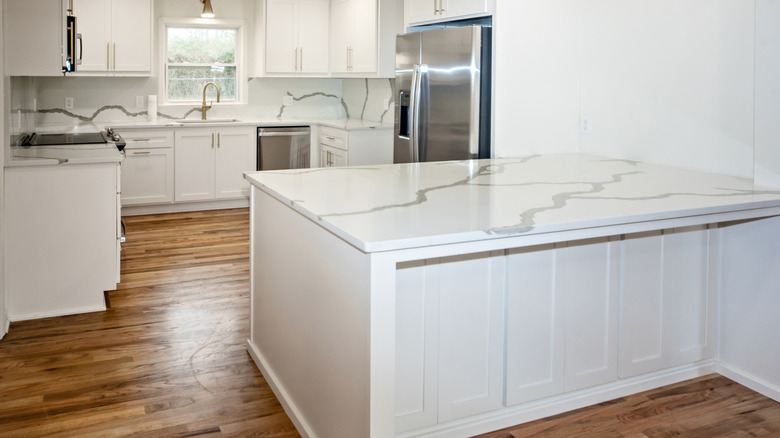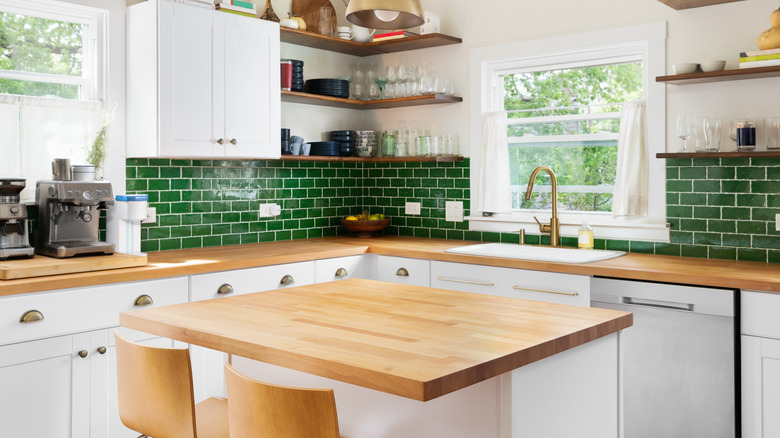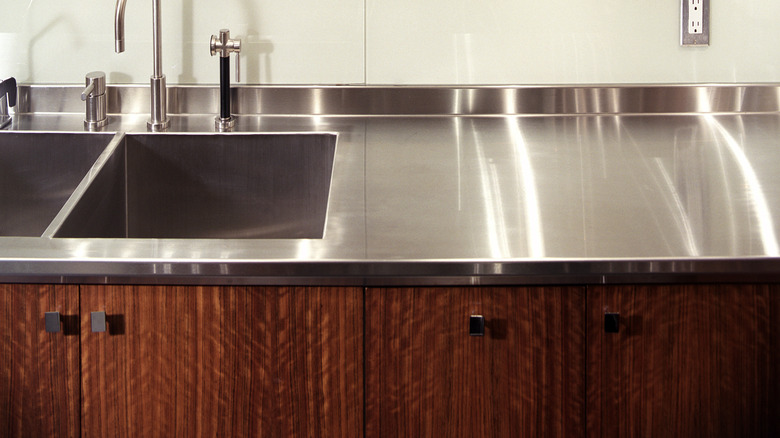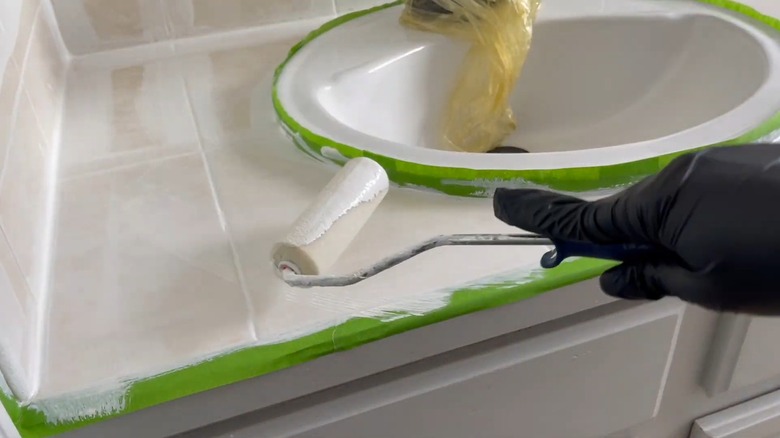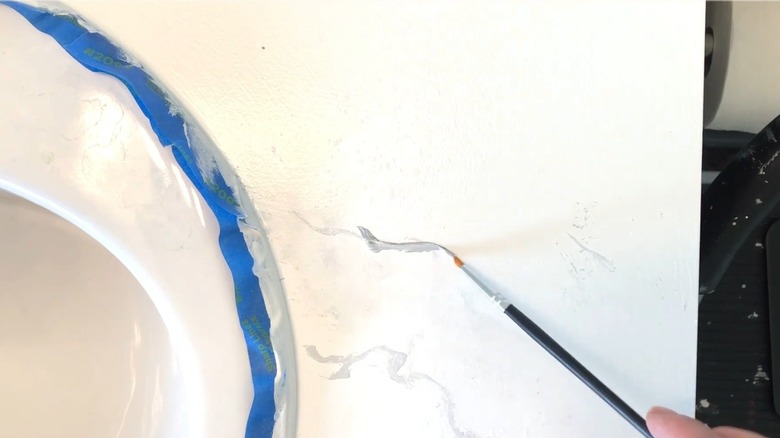7 Countertops You Should Never Attempt To Paint
We may receive a commission on purchases made from links.
Whether you're trying to end your partner's complaints about the "always-dirty" counters or chasing contemporary trends, chances are you looked into replacing your countertops — and dropped the idea immediately. That's $3,000 too much! But with replacements out of the question and the counters still requiring an update, what else could you do on the cheap? Perhaps paint them? After all, it worked out perfectly for your dated cabinets and walls, and seems like a decent blueprint to follow. There are plenty of perfectly edited DIY tutorial videos claiming it's easy and likely to hold up well (which it has for them, although it's only been a week).
Unfortunately, "not all countertops are good candidates for a paint job, and in many cases, painting can lead to a short-lived, disappointing finish," states UK Composite Doors founder and home expert Myles Robinson in his exclusive interview with House Digest. "Some materials simply don't hold paint well, while others have better refinishing options that look more polished and last longer."
Granite, quartz, butcher block, marble, and stainless steel are classic examples (but there's more as you'll discover below). If you're renting, painting your countertop will certainly not sit well with a landlord (even if you're allowed to paint the walls) because it isn't reversed easily and is certain to start looking shoddy over time. If you own your home, painting these types of countertops could drag down the value, as it's definitely not a high-end upgrade. To ensure you don't land in your landlord's bad books or waste your time and money in a disappointing endeavor, we spoke to six experts. Here's a quick roundup of the countertops you should never attempt to paint and better ways to spruce them up.
Don't paint over granite countertops unless you're happy to face chips and bubbles over time
Granite countertops hit a home run of sorts in the 1980s, taking over every homeowner's imagination with their natural beauty and unequaled durability. But with people tiring of granite's busy (read: dirty) aesthetic, the style isn't as hot anymore. These days, quartzite, soapstone, marble, and porcelain are on trend and some homeowners are ready to paint their granite surfaces — often encouraged by DIY content creators.
"While I have seen this trending on social media, granite is non-porous and extremely dense, making it very difficult for paint to adhere," explains Alecia Taylor, designer at CabinetNow, in her exclusive chat with House Digest. "Even with primers, paint tends to chip and wear quickly, especially in busy kitchens." This can make it quite the eyesore with all the paint bubbling and coming apart whenever it's splashed with hot water. That's why painting your dated granite countertops to redesign your kitchen or bathroom is a bad idea, unless you're prepared to redo the paint on a regular basis.
This begs the question: How can you update old granite countertops without paint? "I would recommend professional refinishing with a stone enhancer or resurfacing kit, [which] is a more durable way to refresh granite," says Taylor. Essentially, stone enhancers are oil-based solvents and sealants that impregnate the granite with a dark, wet look, revitalizing its appearance. An example of a highly rated one is the Stonetech Enhancer & Sealer. For a longer-lasting finish, hire a refinisher to apply a professional resurfacing kit to give your counter another lease of life that could last about five to seven years.
Avoid coating quartz countertops with paint because it's highly unlikely to take hold
If there was an Olympics for counter materials that resist paint at a molecular level, quartz would win hands down. Alecia Taylor says, "Quartz is engineered with resins that repel paint. Any attempt to paint it will likely result in peeling over time or an uneven finish." Another problematic area is sanding, without which the paint won't adhere smoothly. Because quartz has a tough exterior, sanding it down is extremely laborious and time-consuming. What's worse, you might even lose manufacturer guarantees as they're often voided for reasons like sandpapering or painting. In short, you should think twice before using paint to update quartz countertops if you're still willing to go through with it.
Although "replacement is often the best option for a long-lasting update," Taylor admits, she does offer refinishing with a tinted epoxy coating as a suitable alternative. To fix imperfections, you can buy a clear epoxy adhesive like Akemi Platinum, mix it with the color you desire, and apply it to any chipped sections. Then you can follow up with a product like Stone Coat's Epoxy Countertop Kit in a either a new quartz tone or another pattern, such as imitation marble.
If you're after a more hands-off fix, there are two further options. Chipping in, during an exclusive interview We Buy Doors Founder Andy Saintilus tells House Digest, "Quartz is best left alone, but if homeowners want a change, they can try vinyl countertop wraps or a new quartz overlay instead of painting." Overlays are made of the same material but are relatively thinner and placed directly on top.
Painted butcher block countertops may be unsafe in kitchens
HGTV bingers might be in for a shock as one clever way Leanne Ford updates butcher block kitchen countertops is by painting them. Yet, here we are recommending the contrary. But before you bring out the pitchforks, hear us out. "Butcher blocks are safe to paint, but I would not recommend it if you plan to use the surface for food prep. Paint can chip and wear unevenly, making it impractical for high-use areas," explains Alecia Taylor. Apart from the timber showing through the peeling areas, it's probable that the hewn paint may flake into the food — especially if you're the type to dispense with a chopping board — making the counter unsafe and unsanitary in your cooking space.
Given these facts, it's no wonder Jamie Hancox, a paint and color expert and managing director at Tikkurila UK, also advises against painting butcher block counters. Hancox exclusively tells House Digest, "You should not paint wood worktops ... however, it would be possible to use special wood oil to alter the appearance of the countertop. You need a wood oil that is food-safe." If you like your wood's grain and are merely worried about scuff marks, Taylor advises staining and a clear coat to complement the wood's natural look and bolster durability. Hope's Tung Oil is one such option, as it's considered food-safe once it has dried and cured. Depending on the brand, you can either expect a slightly glossy or matte finish.
Paint applied to marble countertops will peel, crack, and conceal the characteristics of this high-end material
Like granite, marble doesn't take well to paint, even though it's a slightly more porous stone. Myles Robinson explains, "Marble is another countertop material that should not be painted. The natural veining is a big part of its appeal, and paint will not only cover that up but also struggle to adhere properly. Over time, it can crack and peel, especially in high-use areas." Besides, painting marble countertops requires another level of DIY commitment. You can't simply grab any paint roller and have fun with it. Unless you use a specialized kit, you must first find a suitable paint that's both durable and food-safe. After the selection, you should probably degrease the surface, sand it, apply bonding primer and top it with an epoxy primer. Only then can you layer up paint, and all this effort won't even guarantee a lasting finish.
So, avoid the hassle and stick to a classic marble 101 move — honing. "If marble is looking worn or stained, professional honing and sealing is a far better solution that restores its finish without compromising the integrity of the stone," advises Robinson. During honing, professionals run a hand-held machine fitted with an abrasive pad over the counter. This scrubs the surface clean of etch marks, stains, and scratches, infusing it with a non-reflective matte finish — which happens to be one of the biggest countertop design trends taking over 2025.
Stainless steel countertops are too smooth for paint to adhere properly and create a strong bond
If you've finally outgrown the industrial aesthetic or are in the market to sell, chances are you're looking to rejuvenate the stainless steel countertop gracing your kitchen. Sadly, painting isn't the way to go. "Stainless steel countertops are another material that should never be painted," Myles Robinson says. "The sleek, reflective surface won't hold paint well, and even if it does stick initially, daily wear and tear will cause chipping and peeling in no time."
In case the pattern isn't already apparent, most paints require a slightly rough surface that will allow them to bind — and stainless steel doesn't have one (which is why it resists corrosion so well). While you can certainly sand stainless steel and paint it, starting with a metal primer, the long-term results on a countertop will be a disappointment. Even if you follow all the recommended steps, paint on a stainless steel work surface just isn't likely to withstand the impact of daily kitchen activities.
So, how do you bring new life to your kitchen countertops without replacing or painting them? When it comes to stainless steel, Robinson recommends homeowners buff out scratches and apply brushed or polished finishes to improve the look and durability. This entails a little elbow grease, but if you want to take some of the guesswork out of the process, you can use a kit like Barry's Restore It All Scratch-B-Gone Homeowner Kit.
Painting tile countertops in busy areas is a big no-no
Before you exclaim, "But everyone paints their tile countertops when renovating on the cheap," consider our expert's advice. Myles Robinson states, "Tile countertops are sometimes painted, but it's rarely a good long-term fix. The grout lines make it hard to get an even, lasting coat, and heavy use can lead to fast wear and tear." His sentiments are echoed by Paige NeJame, owner of CertaPro Painters of the South Shore and Boston. "Painted grout lines can crack," NeJame tells us, and "paint doesn't bond well to glazed ceramic or porcelain tiles." While you could propose sanding the counters to improve the paint's grip, this still doesn't ensure long-lasting results.
So, rather than painting your tile countertops, "a much better option is replacing individual tiles or applying a fresh grout stain to brighten up the look without sacrificing durability," Robinson explained. For that, you will have to first clean the grout lines between the glazed tiles with a heavy-duty cleaner like Granite Gold's Grout Cleaner. Only then should you reintroduce a new stain. Go darker to save on stain, or you'll need multiple coats. If you don't want dark grout and simply wish the existing grout was a fresh shade of white once more, you can also try something like this well-reviewed Grout Pen from Rainbow Chalk Markers on Amazon. Alternatively, if your existing grout is beyond saving, consider "regrouting and sealing tiles," recommends NeJame. However, this will be more complicated and labor-intensive since you must remove the existing grout with a tool like the Coitak Tile Grout Saw before regrouting in a new color.
Unless selling, avoid painting laminate countertops like Formica and melamine
Laminate features among the most affordable countertop materials people buy, which is why homeowners don't shy away from covering them with paint when they're looking to quickly elevate their home's look or gearing up for a flip (it's a low-risk investment). But if you put your kitchen to good use, painting might not be the brightest idea. "Laminate countertops can technically be painted, but it's rarely a long-term solution. The surface is non-porous, meaning paint can easily chip, scratch, or bubble under daily use," elaborates Robinson. NeJame adds, "It's risky — people sometimes DIY this because there are kits, but I would not attempt it for a customer for fear of it not looking great or holding up. While some paints claim to work on laminate/Formica, they often scratch easily and won't hold up over time at all."
Laminate resurfacing kits offer a more cost-effective and durable approach, though "where budget allows, new laminate sheets can also be installed," mentions Robinson. Sasquatch Contracting CEO and Founder Mary Peters suggests a different spin in her exclusive House Digest interview. "Instead of painting, PLAM countertops (plastic over wood) or wood countertops can be given a granite-like appearance and sealed with an enamel finish." Robinson says that the countertop kits you see at home improvement big box stores (such as Rust-Oleum's Home Marble Countertop Coating Kit) do work, but she warns that the process will require PPE and vacating your home due to the strong odors. "Personally, I think this method is best fit for a house flip situation, and wouldn't recommend it for your forever home," she concludes.
